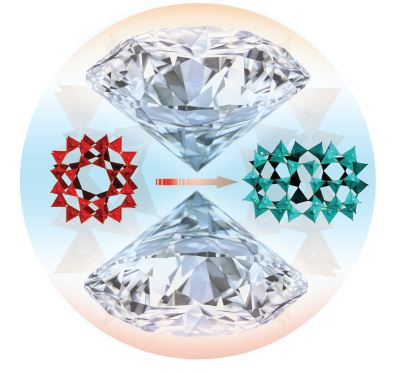Diamond Light Source has been used to profile a new zeolitic microporous solid, created via a process that had previously been thought impossible. Using beam line I15 researchers were able to perform high-pressure synchrotron X-ray diffraction analysis of a material known as a zeolite ITQ-29, and were able to study how it transitioned into a new zeolite. The research also showed that the daughter zeolite is a more efficient adsorber for carrying out the separation of propene from mixtures propane/propene, which is a process of important commercial impact.
Zeolites are microporous, aluminosilicate materials commonly used as adsorbers – materials which gather up chemicals on their surface in a similar way to which the blocks in Tetris accumulate at the bottom of the screen during a game. Commonly used as filter materials, from water purification to separating fission products from nuclear waste, there are around 200 known zeolites. But for the first time the researchers, based at the Spanish National Research Council, CSIC (Spain), the Universidad Politecncia de Valencia, the Universidad de Valencia (Spain), Diamond Light Source and the University of Oxford, were able to create by the first time a new zeolite from an existing one.
“We were partly naive, and partly lucky” says Professor Fernando Rey, of the CSIC “we were pursuing what we thought was some interesting science and we’ve been able to prove that this can be done – it’s a real achievement.”

The first stage of the experiment involved studying the behaviour of the ‘mother’ zeolite, known as ITQ-29, at a relatively high pressure (1.2 GPa; approximately twelve thousand times the earth’s atmospheric pressure). At this pressure the mother zeolite, ITQ-29, compressed but then would snap back into its original shape when returned to a lower pressure. But what hadn’t been expected was that at higher pressures (3.2 GPa), a new zeolite, ITQ-50, would be formed. Furthermore, the researchers were able to show that ITQ-50 is roughly four times more efficient separator of propene and propane than ITQ-29. “Not only have we made a new zeolite, but it is better for this particular application than the mother zeolite” adds Professor Rey.
At this stage, the researchers are only working with a few milligrams of sample of ITQ-50, so a commercial product may be a while yet. The next steps in the research are to perform experiments with differing pressure transmitting mediums, such as helium or methanol, and to add aluminium to the zeolite to influence the chemical reaction.
“To me this is a fascinating discovery that was possible joining expertises from different fields, such as material science, physics, computational chemistry and synchrotron instrumentation” concludes Professor Rey, “it was assumed that this could not happen – the data had been published – and when we showed that it could… well, we were really happy about this!”
Synthesis of a Novel Zeolite through a Pressure-Induced Reconstructive Phase Transition Process Angewandte Chemie Jose L. Jorda,Fernando Rey,German Sastre,Susana Valencia,Miguel Palomino,Avelino Corma,Alfredo Segura,Daniel Errandonea,Raul Lacomba,Francisco J. Manjon,Oscar Gomis,Annette Kleppe,Andrew Jephcoat,Monica Amboage,J. Alberto Rodriguez-Velamazan
10.1002/ange.201305230